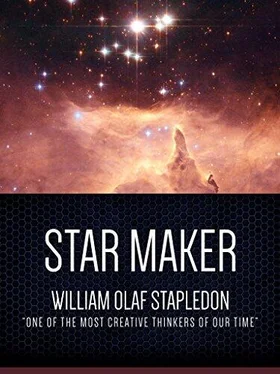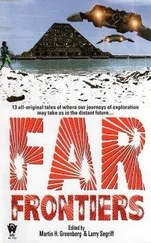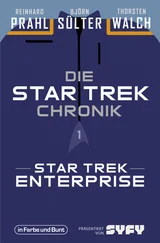And because the best attention of the race was given wholly to the inner life, material and social advancement was checked. The sciences of physical nature and of life never developed. Mechanical power remained unknown, and medical and biological power also. Consequently these worlds stagnated, and sooner or later succumbed to accidents, which might well have been prevented.
There was a second way of devotion, open to creatures of a more practical temperament. These, in all the worlds, gave delighted attention to the universe around them, and chiefly they found the worshipped thing in the persons of their fellow-beings, and in the communal bond of mutual insight and love between persons. In themselves and in each other they prized above all things love.
And their prophets told them that the thing which they had always adored, the universal spirit, the Creator, the Almighty, the All-wise, was also the All-loving. Let them therefore worship in practical love of one another, and in service or the Love-God. And so for an age, short or long, they strove feebly to love and to become members one of another. They spun theories in defense of the theory of the Love-God. They set up priesthoods and temples in service of Love. And because they hungered for immortality they were told that to love was the way to attain eternal life. And so love, which seeks no reward, was misconceived.
In most worlds these practical minds dominated over the meditators. Sooner or later practical curiosity and economic need produced the material sciences. Probing every region with these sciences, the beings found nowhere, neither in the atom nor in the galaxy, nor for that matter in the heart of "man" either, any signature of the Love-God. And what with the fever of mechanization, and the exploitation of slaves by masters, and the passions of intertribal warfare, and the increasing neglect or coarsening of all the more awakened activities of the spirit, the little flame of praise in their hearts sank lower than it had ever been in any earlier age, so low that they could no longer recognize it. And the flame of love, long fanned by the forced draught of doctrine, but now suffocated by the general obtuseness of the beings to one another, was reduced to an occasional smoldering warmth, which was most often mistaken for mere lust. With bitter laughter and rage the tortured beings now dethroned the image of the Love-God in their hearts.
And so without love and without worship the unhappy beings faced the increasingly formidable problems of their mechanized and hate-racked world.
This was the crisis which we in our own worlds knew so well. Many a world up and down the galaxy never surmounted it. But in a few, some miracle, which we could not yet clearly envisage, raised the average minds of these worlds to a higher plane of mentality. Of this I shall speak later. Meanwhile I will say only that in the few worlds where this happened, we noticed invariably, before the minds of that world passed beyond our reach, a new feeling about the universe, a feeling which it was very difficult for us to share. Not till we had learned to conjure in ourselves something of this feeling could we follow the fortunes of these worlds.
But, as we advanced on our pilgrimage, our own desires began to change. We came to wonder whether, in demanding lordship of the universe for the divinely humane spirit that we prized most in ourselves and in our fellow-mortals in all the worlds, we were perhaps impious. We came less and less to require that Love should be enthroned behind the stars; more and more we desired merely to pass on, opening our hearts to accept fearlessly whatever of the truth might fall within our comprehension.
There was a moment, late in this early phase of our pilgrimage, when, thinking and feeling in unison, we said to one another, "If the Star Maker is Love, we know that this must be right. But if he is not, if he is some other, some inhuman spirit, this must be right. And if he is nothing, if the stars and all else are not his creatures but self-subsistent, and if the adored spirit is but an exquisite creature of our minds, then this must be right, this and no other possibility. For we cannot know whether the highest place for love is on the throne or on the cross. We cannot know what spirit rules, for on the throne sits darkness. We know, we have seen, that in the waste of stars love is indeed crucified; and rightly, for its own proving, and for the throne's glory. Love and all that is humane we cherish in our hearts. Yet also we salute the throne and the darkness upon the throne. Whether it be Love or not Love, our hearts praise it, out-soaring reason."
But before our hearts could be properly attuned to this new, strange feeling, we had still far to go in the understanding of worlds of human rank, though diverse. I must now try to give some idea of several kinds of worlds very different from our own, but not in essentials more mature.
1. A SYMBOLIC RACE
ON certain large planets, whose climates, owing to the proximity of a violent sun, were very much hotter than our tropics, we sometimes found an intelligent fish-like race. It was bewildering to us to discover that a submarine world could rise to mentality of human rank, and to that drama of the spirit, which we had now so often encountered.
The very shallow and sun-drenched oceans of these great planets provided an immense diversity of habitats and a great wealth of living things. Green vegetation, which could be classified as tropical, subtropical, temperate and arctic, basked on the bright ocean floors. There were submarine prairies and forests. In some regions the giant weeds stretched from the sea-bottom to the waves. In these jungles the blue and blinding light of the sun was reduced almost to darkness. Immense coral-like growths, honeycombed with passages and swarming with all manner of live-things, lifted their spires and turrets to the surface. Innumerable kinds of fish-like creatures of all sizes from sprat to whale inhabited the many levels of the waters, some gliding on the bottom, some daring an occasional leap into the torrid air. In the deepest and darkest regions hosts of sea-monsters, eyeless or luminous, browsed on the ceaseless rain of corpses which sank from the upper levels. Over their deep world lay other worlds of increasing brightness and color, where gaudy populations basked, browsed, stalked, or hunted with arrowy flight. Intelligence in these planets was generally achieved by some unimposing social creature, neither fish nor octopus nor crustacean, but something of all three. It would be equipped with manipulatory tentacles, keen eyes and subtle brain. It would make nests of weed in the crevices of the coral, or build strongholds of coral masonry. In time would appear traps, weapons, tools, submarine agriculture, the blossoming of primitive art, the ritual of primitive religion. Then would follow the typical fluctuating advance of the spirit from barbarism to civilization.
One of these submarine worlds was exceptionally interesting. Early in the life of our galaxy, when few of the stars had yet condensed from the "giant" to the solar type, when very few planetary births had yet occurred, a double star and a single star in a congested cluster did actually approach one another, reach fiery filaments toward one another, and spawn a planet brood. Of these worlds, one, an immense and very aqueous sphere, produced in time a dominant race which was not a single species but an intimate symbiotic partnership of two very alien creatures. The one came of a fish-like stock. The other was in appearance something like a crustacean. In form it was a sort of paddle-footed crab or marine spider. Unlike our crustaceans, it was covered not with a brittle carapace but with a tough pachydermatous hide. In maturity this serviceable jerkin was more or less rigid, save at the joints; but in youth it was very pliant to the still-expanding brain. This creature lived on the coasts and in the coastal waters of the many islands of the planet. Both species were mentally of human rank, though each had specific temperament and ability. In primitive times each had attained by its own route and in its own hemisphere of the great aqueous planet to what might be called the last stage of the subhuman mentality. The two species had then come into contact, and had grappled desperately. Their battle-ground was the shallow coastal water. The "crustaceans," though crudely amphibian, could not spend long under the sea; the "fish" could not emerge from it. The two races did not seriously compete with one another in economic life, for the "fish" were mainly vegetarian, the "crustaceans" mainly carnivorous; yet neither could tolerate the presence of the other. Both were sufficiently human to be aware of one another as rival aristocrats in a subhuman world, but neither was human enough to realize that for each race the way of life lay in cooperation with the other. The fish-like creatures, which I shall call "ichthyoids," had speed and range of travel. They had also the security of bulk. The crab-like or spider-like "crustaceans," which I shall call "arachnoids," had greater manual dexterity, and had also access to the dry land. Cooperation would have been very beneficial to both species, for one of the staple foods of the arachnoids was parasitic to the ichthyoids.
Читать дальше









![Олаф Стэплдон - Создатель звезд [сборник litres]](/books/433148/olaf-stepldon-sozdatel-zvezd-sbornik-litres-thumb.webp)


